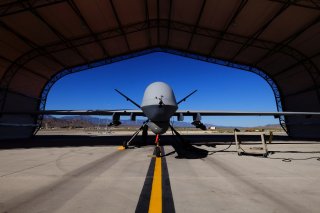The United States Can Be Ukraine's Eye in the Sky
Images and data from U.S. assets could, for instance, show Ukrainian fighters where Russian forces might be vulnerable.
While the Biden administration and the Pentagon are clear that no U.S. forces will fight in Ukraine—for the specific purpose of avoiding “World War III”—supplies, weapons, and ammunition are being delivered to Ukraine at an accelerated pace.
This is despite Russian threats that U.S. and NATO weapons convoys within Ukraine may be targeted.
“We have multiple routes to get secured assistance into the hands of the Ukrainians,” Pentagon spokesman John Kirby told reporters on Monday.
Beyond traditional weapons shipments, drones, surveillance planes, and sensor platforms may be critical aspects of Western support for Ukraine.
“One of the critical elements … being provided to Ukraine, on behalf of NATO and the United States, is information,” said Lt. Gen. David Deptula (Ret.), Dean of the Mitchell Institute for Aerospace Studies and a former Air Force commander during the Gulf War and the Afghanistan War. “The panoply of intelligence, surveillance, and reconnaissance assets (ISR) … can contribute to the awareness of what the Russians are doing [and] where their locations are,” Deptula added. “These are some of the significant elements that assist the Ukrainians in attaining the advantage against their outnumbered forces on the ground and in the air.”
U.S. drones, planes, and sensors are increasingly capable of providing critical ISR data in real-time. Advanced computer algorithms, for example, can identify moments of relevance from vast volumes of data and then transmit organized information to critical command-and-control nodes. The explosion of ISR technology has led to rapid innovations in sensor range, resolution, and image fidelity, reshaping what drones and surveillance planes are capable of. As a result, it is not outside the realm of possibility that NATO air surveillance assets could gather critical intelligence about Russian movements without needing to cross into Ukrainian airspace.
Deptula noted that “you can see on [the] internet that NATO and U.S. aircraft are airborne, [including] the RC-135, Global Hawk, and the F-35, which, by the way, are more than just fighters. They have one of the most capable intelligence, surveillance, and reconnaissance suites to … collect and share information of any aircraft that we have.” “So, there are a variety of different sources that are being used to acquire intelligence and then having it shared with the Ukrainians,” Deptula said.
Images and data from U.S. assets could, for instance, show Ukrainian fighters where Russian forces might be vulnerable in order to carry out well-timed attacks.
Kris Osborn is the Defense Editor for the National Interest. Osborn previously served at the Pentagon as a Highly Qualified Expert with the Office of the Assistant Secretary of the Army—Acquisition, Logistics & Technology. Osborn has also worked as an anchor and on-air military specialist at national TV networks. He has appeared as a guest military expert on Fox News, MSNBC, The Military Channel, and The History Channel. He also has a Master's Degree in Comparative Literature from Columbia University.
Image: Reuters.

